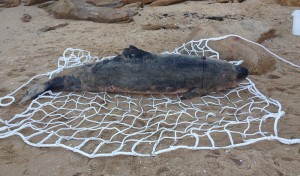Aquatic scientific names in the news …
Dwarf sperm whale
1st May – A 2.42-metre whale, believed to be a rare dwarf sperm whale, died after being stranded at Lake Tyers beach, Victoria, Australia, a species never previously seen in the state.
 Image: Victorian water, environment, land and planning department.
Image: Victorian water, environment, land and planning department.
The Dwarf sperm whale is one of three extant species in the sperm whale family along with the similar sized and more common Pygmy sperm whale and the much larger Sperm whale, and is the smallest species commonly known as a whale, growing up to 2.7 metres in length and weighing up to 250 kilograms, making it smaller than the larger species of dolphin.
An inconspicuous species that is rarely sighted at sea, most information about the them coming from the study of stranded carcasses. The dwarf sperm whale is thought to be widely distributed in tropical and temperate zones of all the world’s oceans, mostly living in deep water and believed to concentrate around the edge of the continental shelf.
One curious feature of Dwarf sperm whales, and the related Pygmy sperm whales, is that they are unique among cetaceans in using a form of “ink” to evade predation in a manner similar to squid. Both species have a sac in the lower portion of their intestinal tract that contains up to 12 litres of dark reddish-brown fluid, which can be ejected to confuse or discourage potential predators.
Kogia sima Owen, 1866 – Dwarf sperm whale
Etymology.
Kogia – Etymology uncertain; possibilities include a reference to a Cogia Effendi, a Turkish naturalist who observed whales in the Mediterranean Sea in the early 1800s, a latinized form of “codger” (although this may be back-formed from Kogia), or maybe a meaningless or nonsense word.
sima – Latin, simus, flat-nosed, snub-nosed – named, “… in reference to its peculiarly short obtuse muzzle.”
Ref. Owen, R. (1866). On some Indian Cetacea collected by Walter Elliot, Esq. Transactions of the Zoological Society, London.

